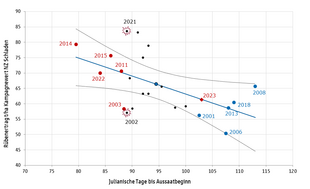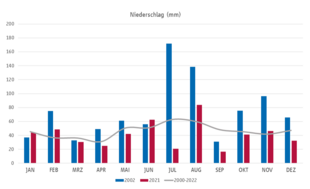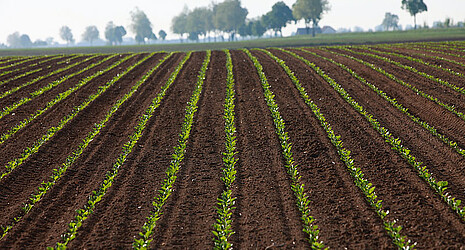It is known from many years of sowing time trials that late sowing dates tend to lead to weaker beet yields, as favourable growing time is simply lost in the important phase of youth development. What is missing at the front is almost impossible to get out at the back.
We have looked at data from practice on this topic: We used the campaign results of the Nordzuckerwerk Schladen (Lower Saxony) and phenological data of the German Weather Service (DWD) from 2000 to 2022. The parameters correlated were beet yield (RE) and reporting date of the start of beet sowing from 4 regionally relevant stations of the DWD. The agricultural instant reporters report the date in the Julian day of the year format, with 1 January being day 1 and 31 December day 365.
To investigate the effect of late and early sowing dates, the mean value of the five earliest (red data points) and latest (blue data points) dates in each case was set in relation to the long-term plant mean (Fig. 1). The correlation cannot be statistically confirmed, but it shows the general tendency towards weaker beet yields with later sowing dates. In the long-term average, sowing was started on day 94, resulting in a beet yield of 66 t/ha..
Table 1 shows the sowing dates and beet yields of the five earliest and latest years of the period from 2000 to 2022. The mean values were set in relation to the long-term campaign results. The early years were 6.6 % above the average beet yield, the late years 12.2 % below:
| Early sowing | Late sowing | ||||
|---|---|---|---|---|---|
| Year | Jul-day | RE t/ha | Year | Jul-day | RE t/ha |
| 2003 | 88,5 | 58,3 | 2001 | 102,5 | 56,2 |
| 2011 | 88,0 | 70,6 | 2006 | 102,5 | 50,4 |
| 2014 | 79,5 | 79,3 | 2008 | 107,5 | 65,7 |
| 2015 | 86,0 | 75,6 | 2013 | 113,0 | 58,6 |
| 2022 | 84,0 | 70,0 | 2018 | 108,0 | 60,4 |
| Mean | 85,2 | 70,8 | Mean | 108,0 | 58,3 |
| rel. | +6,6% | rel. | 12,2 % | ||
However, the data also show that it is not sufficient to derive a prognosis on the harvest result from the sowing date alone, because the yield-determining parameters are manifold. The influence of the year effect on the final result is shown by the years 2002 and 2021. In both years sowing started on day 89, i.e. 5 days earlier than the long-term regional average. Nevertheless, the beet yields show a difference of over 45 %! In 2002, the factory average beet yield was 57.1 t/ha, in 2021, with the same sowing date, 83.7 t/ha.
The decisive factor for this difference was the weather. The year 2002 literally fell into the water. In July and August alone, more than 310 mm of precipitation were measured at the DWD station in Helmstedt, far more than double the multi-year average (Fig. 2). In October and November there was above-average additional water. Some readers will remember patches of water in the fields where ducks felt at home. It did not do the beets any good. Harvesting work was delayed or prevented.
Conclusion: Delayed sowing, into early May, is not necessarily a harbinger of a reduced harvest! However, the foundation for this is still laid at sowing time. So here, despite the perceived pressure, it is important not to rush things at first and to get the seed into the ground under the best possible conditions.
Data: Campaign data: Nordzucker, Schladen plant, Phenological data: German Weather Service, DWD CDC 2023; stations Braunschweig (662), Helmstedt (8585), Evessen (8606), Gr. Vahlberg (8609), climatic data: German Weather Service, DWD CDC 2023; Helmstedt station (2120; 13777).



![[Translate to English:] Strube Broschüren [Translate to English:] Strube Broschüren](/fileadmin/_processed_/2/e/csm_strube-saatzucht-symbolbild-broschueren.jpg_f120f0600b.jpg)

![[Translate to English:] Strube Videos [Translate to English:] Strube Videos](/fileadmin/_processed_/2/2/csm_strube-saatzucht-news_termine-videos.jpg_2b5f252666.jpg)